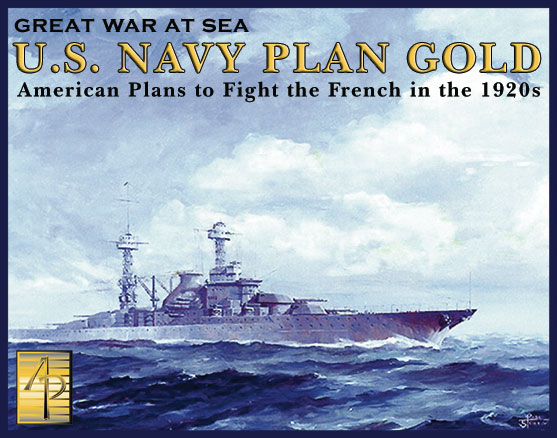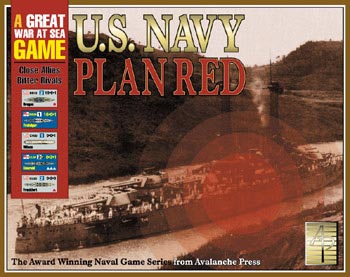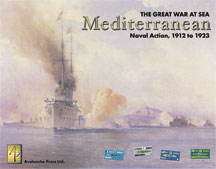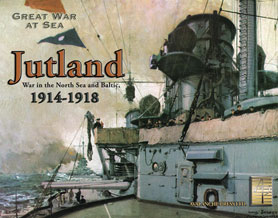| Airship
Strategy in Great War at Sea
November 2011  Great War at Sea: Zeppelins breathes new life into every Great War at Sea game. Sure,
it has more scenarios and adds big, beautiful, fully-tricked-out
airship counters to the GWAS counter mix. But the new advanced
airship rules in Zeppelins let the airships in all
GWAS games break out of the largely non-combatant reconnaissance
role they’ve played until now. From this day forward,
any GWAS fleet that is escorted by airships has powerful offensive
and defensive advantages over unescorted fleets, and can do
things no other fleet has ever been able to do before, like
actively hunting and killing submarines. Great War at Sea: Zeppelins breathes new life into every Great War at Sea game. Sure,
it has more scenarios and adds big, beautiful, fully-tricked-out
airship counters to the GWAS counter mix. But the new advanced
airship rules in Zeppelins let the airships in all
GWAS games break out of the largely non-combatant reconnaissance
role they’ve played until now. From this day forward,
any GWAS fleet that is escorted by airships has powerful offensive
and defensive advantages over unescorted fleets, and can do
things no other fleet has ever been able to do before, like
actively hunting and killing submarines.
And with lots of new airship missions available plus a roster
of airships with widely-varying speed, endurance and combat
capabilities, players will be able to revisit all the GWAS
scenarios they’ve played before and explore the brand
new strategic options which airships bring to the game.
To help players start exploring all this, here’s a
brief summary of the possibilities which the Zeppelins
airships bring to each Great War at Sea game.
 U.S.
Navy Plan Gold U.S.
Navy Plan Gold
French Strategy
As I mentioned in my article series “Strategy
in U.S. Navy Plan Gold,” the French navy of the
1920s is equal to the U.S. Navy in gunnery strength, but is
significantly hampered by low fuel capacity. The worst example
of this is the French destroyers, many of which have only
four fuel boxes each.
This isn’t a problem in the titular Scenario 2, “Plan
Gold,” where the French are protecting their two Caribbean
naval bases at Port-Louis and Fort-de-France against incoming
American invaders. But in scenarios where the French are on
the offensive, the fact that their only two bases are far
to the east of most of their invasion objectives makes low
fuel capacity a big problem. Most French invasion fleets will
lose their destroyer screens before reaching their targets,
and that exposes French transports to attacks by American
submarines and the wickedly powerful (but hard to hit) Wickes-class
American destroyers.
American patrol fleets can force French battleships on escort
duty to burn more fuel by mounting hit-and-run attacks against
them, and that can force those French battleships to turn
back for port before shepherding their charges all the way
to a long-range invasion target. French ships that wish to
intercept American invasion fleets heading for remote targets
like Haiti and Venezuela (in Operational Scenarios 4 and 5)
will have a hard time catching them, since most French capital
ships can only travel at Speed 2 for 15 turns or so before
turning back for port.
And finally, most French ships don’t have the fuel capacity
to sail far west from their bases and then make extended patrols
of the rich French merchant shipping lanes near the Panama
Canal. That gives American and Weimar German raiders a nearly
free hand to sink French merchant shipping there, unless French
submarines get lucky and sink the raiders before they can
do much damage.
For all these reasons, the new advanced airship rules turn
the French airship Dixmude (Z02) into a huge asset
for the French. Dixmude appears in all the operational
scenarios except “Plan Gold.” Dixmude
is a top-of-the-line airship, with a range of 7, an endurance
of 18, a bomb load of 3 and a circled protection rating of
2.
This makes her an ideal offensive weapon: She can skirt the
range of American fighter aircraft out of Puerto Rico and
St. Thomas, move quickly to intercept American invasion fleets
long before they reach their targets, and bomb American transports
from high altitude with little chance of damage from anti-aircraft
fire. She can go on Scout missions to locate enemy raiders,
then shadow them so that French subs and patrol ships can
slowly converge on the raiders and box them in or force them
to flee to port.
Dixmude can also escort French fleets, increasing
French initiative against enemy fleets and hunting and killing
American subs. If she’s escorting a French battlefleet
that intercepts an American battlefleet or invasion fleet,
she can spot for French naval gunnery and double the number
of hits scored on one American ship or multi-ship counter
(e.g., transports) each gunnery impulse.
Finally, in Operational Scenario 9 (“Le Tip and Run”),
Dixmude can take one or two bomb factors, fly all
the way to Florida and bomb U.S. ports and coastal zones to
invoke the Political Meddling and Shock and Awe rules and
put confusion on American naval operations.
American Strategy
The U.S. has several key advantages over the French in Plan Gold,
but her airship capabilities are not one of them. The Italian-built
airship Roma (AS01) is the U.S. Army’s only
airship, and with a range of 4, an endurance of 9, a bomb
load of 1 and an uncircled protection rating of 1, she’s
good for little except coast-watching.
She’d be well used as an escort to an American destroyer
fleet patrolling the Panama Canal area, since her presence
would let the destroyers hunt and kill French subs. On the
other hand, the U.S. Navy’s airships Shenandoah,
Niagara and Los Angeles (ZR01 – ZR03)
are far better, with ranges of 5 or 6, endurances of 12 and
extremely good circled protection ratings of 3 or 4. Still,
they don’t carry bombs, so their best option is to either
go on Scout missions in search of enemy subs and raiders,
or to escort American fleets and provide ASW capability and
spot for American gunnery.
Weimar German Strategy
Zeppelin technology is superior to that of all other airships,
and the late-model Zeppelins available in the 1920s have ranges
of 6 or 7, endurances running all the way up to 27, bomb loads
of 3 or 4 and circled protection ratings of 2 or 3. This makes
them a formidable threat to enemy shipping.
Luckily for the Allies there is only one scenario in Plan
Gold where the Germans have a port that can base airships.
That’s the three-player Scenario 7, “Liberal Bias,”
and any Zeppelins based at St. Thomas can take Scout missions
to locate and bomb enemy raiders, Ground Strike missions to
bomb enemy ports for VPs, and Naval Strike missions to hit
enemy fleets that try to bombard St. Thomas. Since the French
and American players have to score at least double the VPs
scored by the Weimar German player to win, late-model Zeppelins
are a powerful weapon for German victory.
 U.S.
Navy Plan Red U.S.
Navy Plan Red
British Strategy
The British get the late-model R33 – R38 airships, each
of which carries two bomb factors, has a range of 5 or 6,
and an endurance of 15 or 21. The 21-endurance R36 and R37
airships are a particular threat to the Americans, as they
can escort British fleets for long distances and fly long-range
Naval Strike missions against American invasion fleets.
But all British airships can provide the vital service of
naval gunnery spotting for British fleets out of Nova Scotia.
This is crucial because most American battleships outgun most
British battleships on a per capita basis. If the Brits can
assign airship escorts to their intercept fleets, they can
double the gunnery hits scored against American battleships.
American Strategy
Unlike Plan Gold, Plan Red gives the rickety old
Roma a chance to take the fight to the enemy. This
is because the distances in Plan Red are much shorter.
Roma can make it from Boston to the British ports
of Yarmouth or Halifax in just three or four turns, and then
bomb British fleets and aircraft there.
Nevertheless, Roma will take a back seat to the
three U.S. Navy airships Shenandoah, Niagara and
Los Angeles, whose high range and endurance make
them ideal escorts for American invasion fleets heading for
Nova Scotia. Bermuda is also within all three airships’
movement radius from the U.S. mainland, but only if they’re
moving at full-speed. They won’t be able to make it
there while escorting a slow invasion fleet, so their best
role in support of a Bermuda invasion will be to scout ahead
in search of enemy fleets and subs, and to escort faster-moving
American destroyer groups so they can hunt and kill British
subs guarding the approaches to Bermuda.
As mentioned previously, the U.S. Navy airships don’t
carry bombs, so they won’t be able to attack enemy targets
on their own. However, each of them has an air-to-air factor
and all of them have high, circled protection factors, so
they can even hunt British airships effectively. Late-model
British airships have roughly the same range and endurance
as the U.S. Navy airships, but they carry bombs and are thus
a threat to American shipping. But the British airships have
low protection ratings, so the U.S. Navy airships can go out
on Airship Strike missions against them with a reasonable
chance to shoot them down and little chance of getting shot
down in return.
Alternatively, they can escort fast-moving American intercept
fleets in search of British fleets, many of which will be
escorted by British airships since the Brits need the gunnery
spotting help to make up for their lower gunnery strength
per ship. The U.S. Navy airships can then engage the British
airships with air-to-air fire on the battle board with little
danger to themselves. This is an excellent way of neutralizing
the bombing threat from British airships, and after downing
the British airships the U.S. Navy airships can spot for American
naval gunnery.
Sailor’s Warning
Treacherous North Atlantic weather is crucial here for both sides. Scenarios
taking place in November through June often see Gale conditions,
which will destroy all airships that are not at their bases
at the time. So to avoid losing their airships, both players
will need to be careful not to send them too far from base
if the weather is turning gloomy. In the summer and early
fall months the weather is more moderate, so airships can
operate at long range with less worry.
 Mediterranean Mediterranean
Austrian and Italian airships get into the game here, but
none are particularly threatening as offensive weapons in
and of themselves. Several carry no bombs, and those that
do have just one bomb factor. They all have low range and
endurance numbers, but in the close confines of the Mediterranean
that’s less of a concern. All of them are suitable for
Scout and Escort missions, and are best employed for naval
gunnery spotting, bombardment spotting, and hunter-killer
work in tandem with friendly destroyers. Since subs are a
particular danger in the Med, ASW is an excellent role for
these airships to play.  Jutland Jutland
Here the true Zeppelin gets
its moment in the sun, and players can watch Zeppelin technology
evolve over the course of the war. The first military Zeppelin,
L3, makes her appearance in Operational Scenario 9, “Helgoland
Bight,” at the end of August 1914. She carries no bombs
and has Range and Endurance of 4 and 6, so she’ll be
limited to Scout and short-range Escort work. But as the war
in the North Sea and Baltic progresses, the Allies and the
Central Powers get “mine-happy,” laying larger
and more extensive minefields as time goes along. Early-model
German, British and Russian airships will soon get work helping
friendly fleets spot, negotiate and sweep minefields.
The Brits and Russians never got very far with airship construction
during the war, while Zeppelins start carrying bombs in 1915,
have decent range and endurance numbers by the time of the
Battle of Jutland itself, and have high-altitude capability,
a range of 6 and an endurance of 23 by the end of the war.
This means that German airship mission options will increase
as the war progresses, and so will the boost that the advanced
airship rules give the German war effort in Jutland.
Conclusion
But the fun doesn’t stop there. Zeppelins will expand the horizons of
many more Avalanche Press games to come. U.S. Navy Plan
Black will return in book form before long, giving the
late-model Zeppelins included here a chance to take on the
U.S. Navy with full support from the High Seas Fleet. Other
Rainbow Plan games will follow, and any Great War in the Air
game wouldn’t be complete without zeppelin combat. And
the really weird alternative history possibilities are endless
(think Sky Captain . . . ).
But that’s a subject for another day. Have fun with
all the new gaming options that Zeppelins brings
to Great War at Sea!
Click
here to buy Zeppelins now! |


